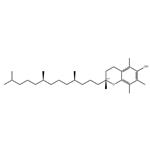Biologic activity and Efficacy of vitamin E
Mar 3,2022
Discovered in 1922 by Evans and Bishop as a dietary factor required for rat reproduction,vitamin E is the most abundant antioxidant in the skin and the most important lipid-soluble, membrane-bound antioxidant in the body. Its role as an antioxidant was suggested when animals made ill by ingesting rancid fat could be cured with wheat germ oil concentrates containing tocopherols.Vitamin E is the generic name of a mixture of lipid-soluble phenols, tocopherols and tocotrienols—the structures (shown below) feature an aromatic chromanol head and a 16-carbon hydrocarbon tail. The number of methyl substituents on the chromanol ring gives rise to α, β, γ, and δ isomers, whereas saturation of the hydrocarbon chain defines the tocopherol form (with a saturated chain, constituting eight stereoisomers of each of the four isomers of tocopherol) or the tocotrienol form (with an unsaturated chain and two stereoisomers of each of the four tocotrienol isomers).

Biologic activity
The biologic activity of vitamin E generally has been believed to be due to its antioxidant action of inhibiting lipid peroxidation by scavenging the chain-propagating peroxyl radicals (ROO•) in biological membranes, thereby eliminating the chain reaction of fatty acid radical propagation.Recent research has further demonstrated that vitamin E also modulates receptors (such as the low-density lipoprotein receptor) and is a cell signaling molecule for transcription factors that regulate target genes connected to antioxidant defense, inflammation, cell cycle regulation, extracellular matrix, cytoarchitecture, lipid uptake, and cholesterol synthesis.Taber and Atkinson propose that vitamin E does not directly modulate these signaling pathways, but rather that oxidative stress alters membrane fluidity or specific lipids, both of which can, in turn, modulate the receptors and signaling pathways. These researchers propose that vitamin E’s sole biologic role is as an antioxidant to protect polyunsaturated fatty acids and membrane fluidity and lipid domains.
Efficacy
The efficacy of the tocopherols in comparison with the tocotrienols is currently under investigation in many laboratories. Because there are diverse in vitro and animal models, it is difficult to estimate the physiologic importance and health benefits to humans from these different investigations. Also, the efficacy of each isomer and form of vitamin E depends upon many parameters: (1) genetic variability among individuals in absorption, distribution, and metabolism, (2) absorption (either gastrointestinal or percutaneous), (3) affinity and efficacy of transport by the specific α-tocopherol transfer protein (α-TTP) (which has a highest affinity for d-α-tocopherol), (4) tissue distribution, and (5) metabolism within each tissue.
Related research
It is generally believed that the tocotrienols exhibit stronger antioxidant activity when compared to the tocopherols.Although past epidemiological studies, as well as in vivo and in vitro studies, indicate vitamin E intake has protective properties against carcinogenesis,some recent studies on vitamin E show the contrary.The largest vitamin E randomized trial to date, selenium and vitamin E Cancer Prevention Trial (SELECT), indicated that α-tocopherol supplementation increased prostate cancer incidence.
However, the seemingly contradictory results of the SELECT trial should not discourage the use of vitamin E as a protective agent, but rather should be an indicator of the complexities of vitamin E.Possibly this contradictory data will be resolved if studies on specific isomers (α, β, γ, δ) and stereoisomers are undertaken.
- Related articles
- Related Qustion
- The photoprotective effects of vitamin E Mar 3, 2022
The photoprotective effects of vitamin E (α-tocopherol) have been studied extensively. Whereas most studies have been performed in animals, several studies exist investigating the photoprotective effects of topically applied vitamin E also
Selenium (Se) was recognized to be an essential trace element in humans and animals in the late 1950s. Se is a specific component of important selenoproteins and Se-dependent enzymes required for antioxidant defense, reduction of inflammati....
Mar 3,2022Inorganic chemistryHexylresorcinol is an organic compound with local anaesthetic, antiseptic, and anthelmintic properties.....
Mar 3,2022Plant extractsVitamin E
2074-53-5You may like
- Acid phosphatases and Phosphatase, Acid from wheat germ
May 27, 2024
- The structure and Biological function of Cytochrome C
May 17, 2024
- Is CJC-1295 DAC same as CJC-1295?
May 16, 2024
- Vitamin E
-

- $6.00 / 1kg
- 2024-05-29
- CAS:2074-53-5
- Min. Order: 1kg
- Purity: More than 99%
- Supply Ability: 2000KG/Month
- Vitamin E
-

- $0.00 / 25kg
- 2024-05-29
- CAS:2074-53-5
- Min. Order: 25kg
- Purity: ≥50.0%
- Supply Ability: 10tons
- Vitamin E powder
-

- $0.00 / 1KG
- 2024-05-24
- CAS:2074-53-5
- Min. Order: 1KG
- Purity: 50% HPLC
- Supply Ability: 1000KG





